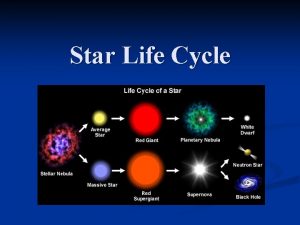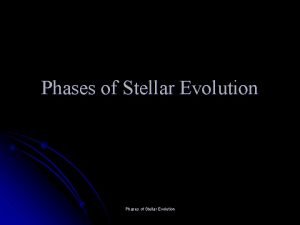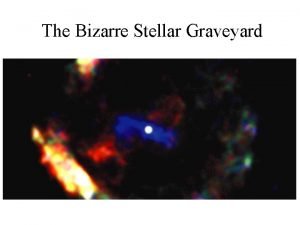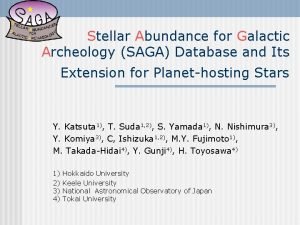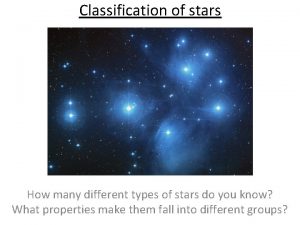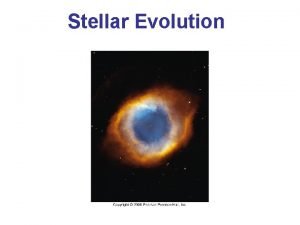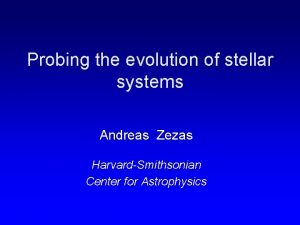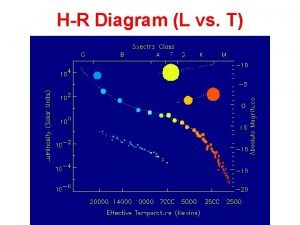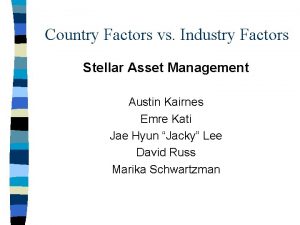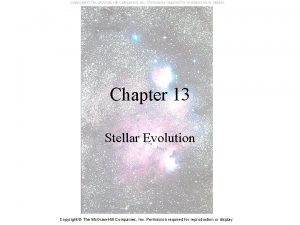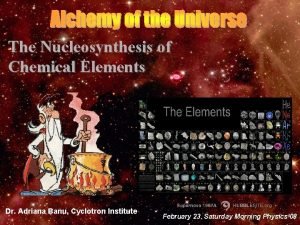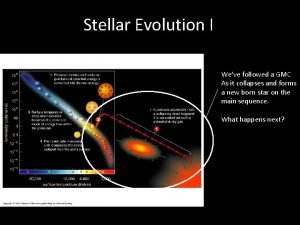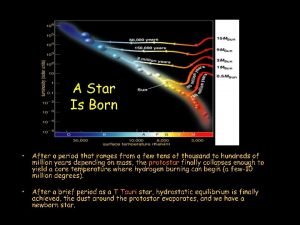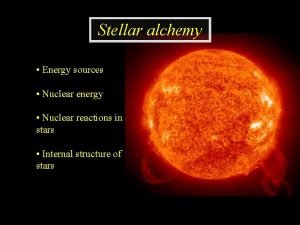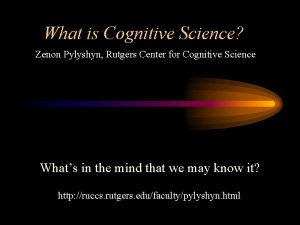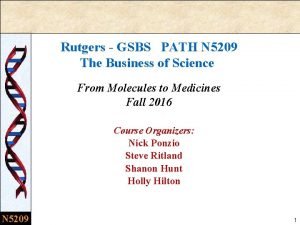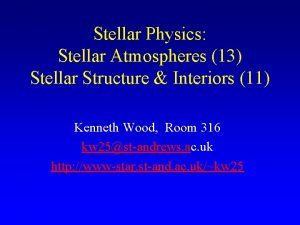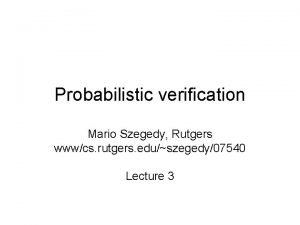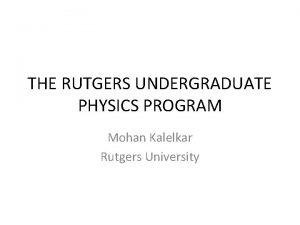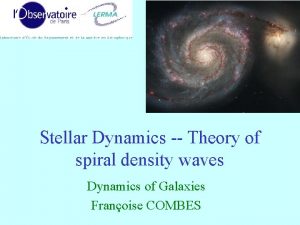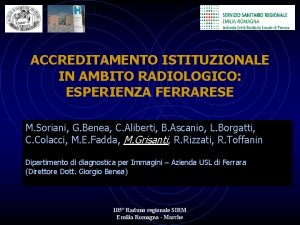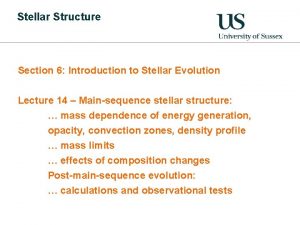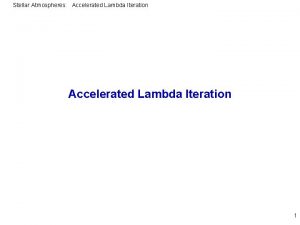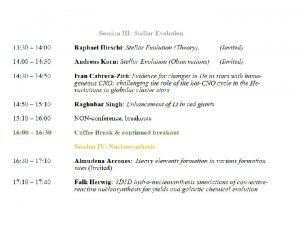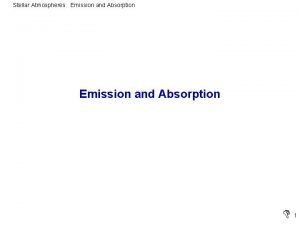Laura Ferrarese Rutgers University Lecture 2 Stellar Dynamics
































- Slides: 32

Laura Ferrarese Rutgers University Lecture 2: Stellar Dynamics SIGRAV Graduate School in Contemporary Relativity and Gravitational Physics

Lecture 2: Outline 1. As spectacular as unique: the Milky Way 2. Observational requirements (beyond the Milky Way) and Instrumentation ground and space based 3. Mathematical formalism 4. Application: M 87 5. Biases and Systematics 6. Results and Concluding Remarks

The Milky Way d The galactic center is only 8 kpc away. Because of heavy dust absorption, a clear view of the stars in the vicinity of the galactic center can only be obtained in the nearinfrared. d In the K-band (2. 1 m), the diffraction limited resolution is 0. 06 arcsec: h A star which travels at a speed of 27 km/s, would move relative to the background stars by one resolution element in one month. Proper motion studies are therefore feasible.

The Milky Way d Schödel et al. 2002 (Nature 419, 694): CONICA/NAOS adaptive optics images at the ESO/VLT. d Movie showing the proper motion of the ‘S 2’ star over a period of 10 years. The star is on a bound, highly elliptical orbit around Sgr. A*, with an orbital period of 15. 2 years, a pericenter distance of 17 light hours, and an orbital semi-major axis of 5. 5 light days. d This single stellar orbit allowed to measure the enclosed mass: 3. 7 106 M ! There are virtually no assumptions made, except for those regarding the stellar mass distribution (which needs to be known to determine how much of the enclosed mass is in a central point source. ) d The measurements imply a central mass density in excess of 1017 M pc-3, excluding with high confidence that the central dark mass consists of a cluster of unusual stars or elementary particles. This leaves little doubt of the presence of a supermassive black hole at the centre of the galaxy in which we live.

The Milky Way d Further support to the existence of a SBH in the MW come from the detection of an X-ray flare, using the Chandra satellite (Baganoff et al. 2001, Nature, 413, 45). The flare is interpreted as due to instability in the mass accretion rate. The timescale of the event is consistent with the light crossing time for the inner accretion disk (~10 Schwartzchild radii) September 1999 October 2000

Beyond the Milky Way d The most nearby large galaxy, M 31, is 100 times farther away than the galactic center. h proper motion timescales are a factor 100 longer; h stellar mass density is a factor 1003 larger, therefore individual stars are not resolved. d In (almost) every galaxy beyond the Milky Way, proper motion studies of individual stars are not feasible, and we have to resort to extract the velocity field from the integrated (along the line of sight) stellar light. This presents several problems: h Stellar absorption lines are faint and long exposure times are required to collect the necessary signal-to-noise. For instance, it would take the Hubble Space Telescope more than 100 orbits (more than any TAC would allocate to the project) to obtain spectra suitable for stellar dynamical studies in M 87, the c. D galaxy in the Virgo cluster. h The modeling is difficult: the orbital structure is unknown and difficult to derive from the data because of line of sight projections h There might be a fundamental mathematical limitation to the accuracy of the mass measurements that can be derived from dynamical modeling.

Requirements d Stellar kinematics (bottom figure): need to cover the Ca or Mg absorption lines at 8500 and 5200 Å respectively, with spectral resolution > 60 km/s (depending on the mass of the BH). d Gas kinematics (top figure): H +NII region at ~6500 Å, with spectral resolution ~100 km/s

Instrumentation - HST d Challenge: h to detect the dynamical signature of a supermassive black hole, we need to observe the region of space - the sphere of influence - within which the black hole gravitational potential dominates over that of the surrounding stars. The farther in we are within this region, the more markedly keplerian the rotation and velocity dispersion curves will be. The ‘black hole radius of influence’ is: rinfl = GMBH/ 2 ~ 50 (MBH/109 M )/( 2/300 km s-1) pc ~ 0. 7 at Virgo where is the stellar velocity dispersion and MBH is the black hole mass. d Even at the distance of Virgo (15 Mpc), the BH sphere of influence is very small. h This explains why most secure SBH detections have been made using the Hubble Space Telescope: ¢ ¢ ¢ Primary mirror is 2. 4 m in diameter (small for ground-based standards) but Resolution (in the optical): 0. 1 arcsec (5 -10 times better than ground based telescopes) Point Spread Function is very stable

Instrumentation - Ground Based d Compared to HST, ground based telescopes have the great advantage of a larger collective area, but they generally lack the spatial resolution for systematic SBH searches. h this will change when adaptive optics will be implemented in the optical. d Integral Field Units (IFU) are much more suited than long-slit spectroscopy for kinematical (both stellar and gas) studies on large scales. Available IFUs: h WHT: Sauron http: //www. strw. leidenuniv. nl/sauron/ h CFHT: Gr. IF (Near IR) http: //www. cfht. hawaii. edu/Instruments/Spectroscopy/Gri. F/ h Gemini: GMOS http: //www. gemini. edu/sciops/instruments/gmos. IFU. html h VLT: VIRMOS http: //www. eso. org/instruments/vimos/ h AAT: SPIRAL http: //www. aao. gov. au/astro/spiral. html h Sauron data for NGC 4365, a galaxy known to have a kinematically decoupled core

Mathematical Formulation d Galaxies are composed of several hundred billion stars. In the most general case, each of these stars: h moves through the gravitational potential of the entire galaxy (produced by the effect of every other star, and any “dark” mass distribution). h interacts with nearby stars through stellar encounters. d Observationally, except for a handful of cases, we do not observe individual stars. All we can observe is the integrated light of stars along the line of sight: h stellar surface brightness (projected on the plane of the sky). h projected stellar rotation and velocity dispersion (integrated along the line of sight). h higher moments of the absorption line profiles. d From this, we want to arrive to a self-consistent description of the stellar system: derive the mass density (luminous + dark matter) which reproduces the observables. d This seems hopelessly complicated! Thankfully, there a number of simplifications we can make.

Collisionless Stellar-Dynamical Systems d Real galaxies can be approximated as collisionless systems, i. e. the time scale over which interactions between stars lead to a significant change in each star’s velocity is long compared to the galaxy’s age. d The Crossing Time is defined as the typical time scale for orbital motion; i. e. the time it takes a typical star to cross the system: where h is the average stellar density inside the half mass radius. d The Relaxation Time is defined as the characteristic time scale over which, due to the cumulative effect of stellar encounters, a typical star acquires a transverse velocity comparable to its initial velocity: where N is the total number of stars in the galaxy.

Collisionless Stellar-Dynamical Systems d A typical galaxy has N = 1011 stars but is only t = 100 crossing times old, so the cumulative effect of stellar encounters is insignificant: d In this limit, each star moves in the smooth gravitational field (x, t) of the galaxy. This greatly simplifies the problem, since instead of thinking about the motion of one point in a phase space of 6 N dimensions (3 spatial coordinates + 3 velocity coordinates, times N stars), we can think about the motion of N points in a phase space of just 6 dimensions. d Therefore, a complete description of the system is given by the one-particle distribution function: f is equal to the number of stars in the phase space volume d 3 xd 3 v centered on (x, v) at time t. d The distribution function obeys a continuity equation, i. e. the rate of change of the number of stars within a phase space volume d 3 xd 3 v is equal to the amount of inflow minus the amount of outflow: d This is known as the Collisionless Boltzmann Equation (CBE)

Collisionless Stellar Systems d The distribution function tells us all we ever want to know about the dynamics of the system: once we know the distribution function, the CBE can be solved to give the total gravitational potential, which is related to the total mass density (including dark matter and a putative central SBH) by Poisson’s equation: d But how can we derive the distribution function from the observables? h Apart for a multiplicative factor (which we will assume of order unity for the sake of argument), the stellar mass density is just the integral of the DF over all velocities: Velocity dispersion, arising because not all the stars near a given point x have the same velocity h The mean stellar velocity is: Streaming motion h So, in principle, if we know the stellar mass density, the three components of the streaming motion, and the three diagonal components of the velocity dispersion, then we can derive the distribution function, the total gravitational potential (from the CBE), and the total mass density (from Poisson’s equation). h Unfortunately, even assuming that none of the observables depends on time (i. e. the system is in a steady state), we simply cannot measure all seven quantities.

Collisionless Stellar-Dynamical Systems d To gain further insight onto the system, it is often convenient to take moments of the CBE, which directly relate the gravitational potential to the mean streaming velocity, velocity dispersion and stellar mass density. The zeroth and 1 st order moments give the Jeans equations: h Integrating the CBE over all velocities: h Multiplying the CBE by a velocity component vj and then integrating over all velocities: d If further assumptions are made, the Jeans equations can sometimes be simplified to such an extent that they can be solved analytically or numerically.

Spherical Systems d Let’s consider the very simple case of a spherically symmetric, steady-state stellar system for which vr = v = 0. In this case, all derivatives with respect to t, and vanish, and the first moment (wrt vr) of the CBE becomes (in spherical coordinates): Since d /dr=GM(r)/r 2, this equation can be rearranged as: d Therefore, M(r) is a function of five variables, namely the stellar mass density, the streaming circular velocity, and the three components of the velocity dispersion. d Unfortunately, real observations only allow us to measure three quantities, namely the surface brightness profile at each projected radius, the projected circular velocity, and the line of sight velocity dispersion. It follows that we cannot build a unique model of an external galaxy (even in the oversimplified case of a spherical system) based on the observables only. More assumptions need to be made.

Two Simple Cases (1) d The easiest case is to assume that the stellar mass density follows the luminosity density, the galaxy does not rotate and that the velocity ellipsoids are spherical throughout the galaxy, i. e. the velocity field is isotropic. In this case: (2) d The second case is to assume that the mass density follows the luminosity density, i. e. (r) = (r), with = constant. In this case, (1) becomes: (3) d The problem is: both cases can reproduce exactly the same observational constraints!

Application: M 87 d M 87 was the first galaxy for which the presence of a supermassive black hole was claimed (Sargent et al. 1978, Ap. J, 221, 731). h Central galaxy in the Virgo Cluster. h Very well known radio galaxy.

Application: M 87 d Projected surface brightness profile (left) and velocity dispersion profile (right) for M 87 (from Young et al. 1978, Ap. J, 221, 721; Sargent et al. 1978, Ap. J, 221, 731) 1. 2. Steady-state, spherical, isotropic dynamical models fits to the data: a) b) c) with black hole & seeing convolved no black hole

Application: M 87 d Steady-state, spherical, isotropic dynamical models applied to M 87 by Sargent et al. (1979, Ap. J, 221, 731). The data is interpreted as evidence of a central 5 109 M SBH.

Application: M 87 d However, lets now consider a case in which we impose the mass to light ratio throughout the galaxy to be constant: M(R)/L(R)=constant. h Notice that M(R) here is not the stellar mass, but includes a central supermassive black hole (and anything else). h In this case, the system is not isotropic and equation (2) can be used to determine the degree of anisotropy. d Right: The computed profile for the radial velocity dispersion and anisotropy parameter in M 87. This model assumes a constant M(R)/L(R) (i. e. no central SBH!) and gives just as good a fit to the observables as the isotropic model by Sargent et al. (1979). From Binney & Mamon (1982, MNRAS, 200, 361)

Application: M 87 d Spherical, isotropic and anisotropic models for M 87, using more recent data (from van der Marel 1994, MNRAS, 270, 271).

M/L vs Anisotropy d In other words, anisotropy in the velocity dispersion, and a varying mass to light ratio, can mimic the same observables. Here is a more intuitive way to see how this ambiguity comes about. Consider the Jeans equation once more: (1) d In a real galaxy, -dln /dlnr is of order or less than +1, while -dln r 2/dlnr must always be smaller than +1. h If the galaxy is isotropic, then the last two terms drop out, and we are left with a positive solution for M(r). h Let’s take the extreme case of a highly anisotropic galaxy for which v =v =0. In this case, the last two terms offset the first two, with the effect of reducing M(r)!

Breaking the Degeneracy d Tangentially anisotropic DFs are generally more flat-topped and those from radially anisotropic models are more peaked than an isotropic profile (figure from van der Marel & Franx 1993, Ap. J, 407, 525).

Anisotropy in Giant Ellipticals Relation between v/ and ellipticity for an isotropic system From Illingworth 1981

More General Galaxy Models d Let’s look at the systems we just discussed in terms of the distribution function. d Let’s define an integral of motion as any function of velocity and coordinates whose time derivative vanishes for all orbits: It can be shown easily that any integral of motion, or any function which depends on (x, v, t) only through an integral of motion, is a solution of the time dependent CBE. Again, let’s limit ourselves to time-independent systems.

More General Galaxy Models d A spherical, isotropic system, admits only one integral of motion: the total energy. In other words, the distribution function depends only on E: f = f(E) In this case, there is a one-to-one correspondence between mass density and distribution function: given (r) we can analytically find f(E) which self-consistently generates (r) (and vice versa). d If the distribution function depends on more than one integral of motion, the velocity dispersion tensor cannot be isotropic. The simplest case is one where f=f(E, Lz), with Lz the z -component of the angular momentum. These “ 2 -Integral” models can yield reasonable approximations to some stellar systems. As in the spherical, isotropic model. there is only one distribution function that can generate a given (r) and the net streaming motion if the direction d However, in most systems, two integrals are not sufficient to fully characterize the stellar orbits. In fact, numerical calculations show that most orbits are not completely described by just two integrals, i. e. they admit a third integral. There is no general expression for this integral of motion, although in nearly spherical systems it is approximated by the magnitude of the total angular momentum. In full ‘ 3 -integral models’, there is not a unique distribution function which generates a given (r) and net streaming motion. In other words, a change in the potential can always be compensated with an appropriate change in the distribution functions to give exactly the same observables

Biases and Systematics d This indeterminacy might preclude us from pinning down the gravitational potential d uniquely when using 3 -integral models (Valluri, Merritt & Emsellem, 2002, astro-ph/0210379). Simulated dataset designed to reproduce HST/STIS data for M 32 - Results obtained for Nc = number of constraints = 571 (masses, v , s , h 3 , h 4) and varying number of orbits No N 0/Nc=2. 5 N 0/Nc=15. 6 N 0/Nc=10. 1 N 0/Nc=5. 0 N 0/Nc=10. 1 N 0/Nc=15. 6 N 0/Nc=5. 0 N 0/Nc=2. 5 Valluri, Merritt & Emsellem (2002)

A Complete Census of SBH Masses from Stellar Dynamical Studies MBH + - 8 (10 solar masses) Reference 30. 3 26. 0 1. 1 Cappellari et al. 2002, 578, 787 c. E 2 0. 8 0. 025 0. 005 Verolme et al. 2002, MNRAS, 335, 517 N 3115 S 0 9. 8 9. 2 3. 0 Emsellem et al. 1999, MNRAS, 303, 495 N 3379 E 1 10. 8 1. 35 0. 73 Gebhardt et al. 2000, AJ, 119, 1157 N 821 E 6 24. 7 0. 37 0. 24 0. 08 Gebhardt et al. 2003, Ap. J, 583, 92 N 1023 S 0 10. 7 0. 44 0. 06 Gebhardt et al. 2003, Ap. J, 583, 92 N 2778 E 23. 3 0. 14 0. 08 0. 09 Gebhardt et al. 2003, Ap. J, 583, 92 N 3377 E 5 11. 6 1. 00 0. 9 0. 1 Gebhardt et al. 2003, Ap. J, 583, 92 N 3384 SB(s)0 - 11. 9 0. 16 0. 01 0. 02 Gebhardt et al. 2003, Ap. J, 583, 92 N 3608 E 2 23. 6 1. 9 1. 0 0. 6 Gebhardt et al. 2003, Ap. J, 583, 92 N 4291 E 26. 9 3. 1 0. 8 2. 3 Gebhardt et al. 2003, Ap. J, 583, 92 N 4473 E 5 16. 1 1. 1 0. 5 0. 8 Gebhardt et al. 2003, Ap. J, 583, 92 N 4564 E 14. 9 0. 56 0. 03 0. 08 Gebhardt et al. 2003, Ap. J, 583, 92 N 4649 E 2 17. 3 20. 0 4. 0 6. 0 Gebhardt et al. 2003, Ap. J, 583, 92 N 4697 E 6 11. 9 1. 7 0. 2 0. 3 Gebhardt et al. 2003, Ap. J, 583, 92 N 5845 E* 28. 5 2. 4 0. 4 1. 4 Gebhardt et al. 2003, Ap. J, 583, 92 N 7457 SA(rs)0 - 13. 5 0. 035 0. 011 0. 014 Gebhardt et al. 2003, Ap. J, 583, 92 Galaxy Type I 1459 E 3 N 221 Distance (Mpc)

Points to Bring Home 1) Dynamical measurements which do not resolve the SBH sphere of influence can severely bias the mass measurement. This has in fact happened in the vast majority of ground based studies (e. g. Kormendy et al. 1992, 1997, 1998; Lauer et al. 1992; Fisher et al. 1995; Gebhardt et al. 1997; Magorrian et al. 1998)

Points to Bring Home 2. The more complex the dynamical models, the larger the number of observational constraints needed. The combination of HST data (in the innermost regions) and ground based/2 D data (in the outer regions) for M 32 constitutes the best suite of data for any galaxy so far (Verolme et al. 2002, MNRAS, 335, 517) STIS data V SAURON data h 3 V h 4 h 3 h 4

Points to Bring Home d Model parameters and internal structure are much more strongly constrained with the use of the 2 D data (Verolme et al. 2002, MNRAS, 335, 517) 3 level Four slits + STIS SAURON + STIS

Suggested Readings d The SBH in the Milky Way: Schodel, et al. 2002, Nature, 419, 694 Ghez et al. 2003, astro-ph/0303151 d Stellar Dynamics: Binney & Tremaine, ‘Galactic Dynamics’, Princeton University Press, Chapter 4 d M 87, a practical case: Sargent et al. 1979, Ap. J, 221, 731 Binney & Mamon 1982, MNRAS, 200, 361 van der Marel 1994, MNRAS, 270, 271
 Indica el reflexivo reciproco adecuado
Indica el reflexivo reciproco adecuado 01:640:244 lecture notes - lecture 15: plat, idah, farad
01:640:244 lecture notes - lecture 15: plat, idah, farad Power system dynamics and stability lecture notes
Power system dynamics and stability lecture notes Power system dynamics and stability lecture notes
Power system dynamics and stability lecture notes Stellar heaven
Stellar heaven Mizar luminosity
Mizar luminosity Stellar evolution diagram
Stellar evolution diagram Zero age main sequence
Zero age main sequence Stellar motion matlab
Stellar motion matlab Virgo stellar stream
Virgo stellar stream Masses in the stellar graveyard
Masses in the stellar graveyard Stellar evolution lab the life cycle of a star answer key
Stellar evolution lab the life cycle of a star answer key Stellar hosting iptv
Stellar hosting iptv Stellar assessment
Stellar assessment Stellar saga
Stellar saga What is stellar parallax?
What is stellar parallax? Stellar evolution
Stellar evolution Stellar
Stellar Stellar formation
Stellar formation Stellar asset management
Stellar asset management Stellar evolution
Stellar evolution Abundance of elements
Abundance of elements Stellar evolution
Stellar evolution Stellar evolution
Stellar evolution Stellar wifi
Stellar wifi Stellar alchemy
Stellar alchemy Zenon pylyshyn
Zenon pylyshyn Webteg
Webteg Symplicity rutgers law
Symplicity rutgers law Marian
Marian Rutgers pharmacy fellowship
Rutgers pharmacy fellowship Rutgers gsbs
Rutgers gsbs Sona systems uci
Sona systems uci






